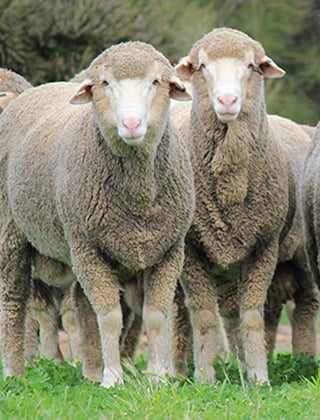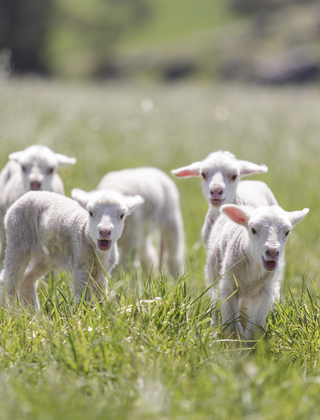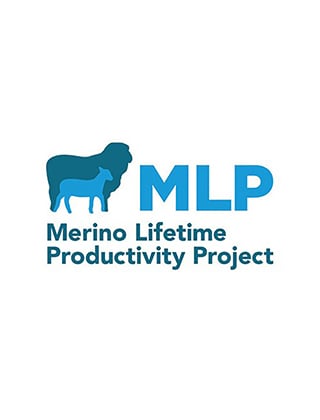A day of firsts and lasts – the MLP project New England field day
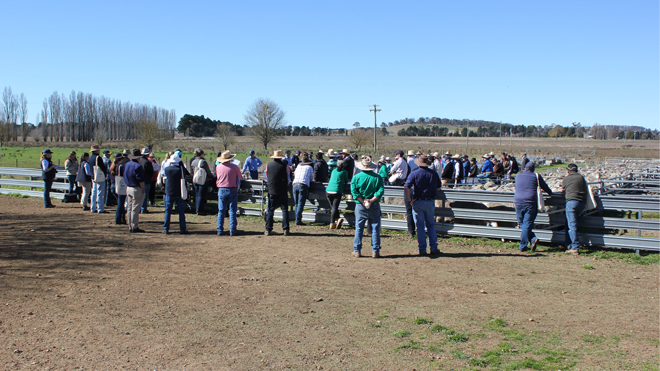
The final MLP project sheep field day was held at the New England site, where research breeding values for flystrike were also launched.
The last of the Merino Lifetime Productivity (MLP) project data was collected in July 2024, rounding out nearly 10 years of data collection which has seen the creation of approximately 2,000,070 data points. The project will now focus on the core project analysis, generating outcomes to help enhance breeding and selection systems to produce ewes that are more productive through life.
Ahead of the final shearing event at the New England site in July, an enthusiastic crowd of more than 100 attendees gathered on 29 May for the final sheep field day at CSIRO’s Chiswick property. The display of 30 pens of ewes, the daughters of industry sires, garnered significant interest along with the newly released breech strike research breeding values.
On the day, the MLP New England site manager Dr Jen Smith explained to the crowd that the 6- to 7-year-old ewes had experienced a reasonable season over the past year with an exceptional conception result resulting in an average of 146% lambs weaned to ewes joined. Despite raising a significant number of lambs, the ewes had regained their condition and presented well on the day.
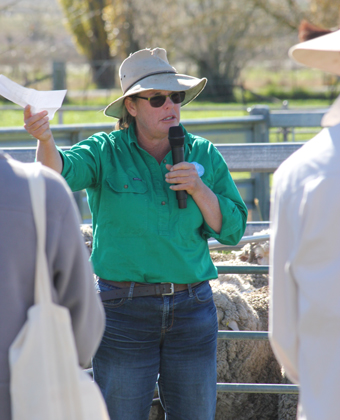
Dr Jen Smith, CSIRO, addressing the New England field day.
Hearing from the classers
Classers for the MLP site, Angus Carter from Nutrien and Andrew Calvert of Wool Solutions, both spoke at the final sheep field day.
Angus Carter highlighted the 25% variation in performance among the progeny groups and emphasised the power of genetics from just one generation of progeny. He explained his approach to classing using a triangle model, with (1) structure and size on one side, (2) fleece weight on another, and (3) micron on the third side. He said that focussing too much on one side sacrifices the benefits of the others, advocating for a balanced approach in the middle. Angus also mentioned that he looks for nourishment in the tip, not too much face cover, and good feet which are needed in the wet New England conditions.
Andrew Calvert commended the sire owners for entering their sires into the lifetime evaluation with the industry scrutiny that came with it. He also congratulated CSIRO on the management of the sheep, suggesting that if sheep are managed well they can express their full genetic potential. Andrew described the classing approach he was tasked with, the Professional class, a five-way approach that selected the top 1% for use in an ET donor program or similar, the next 10% for a stud nucleus, followed by flocks, sales and then culls. He emphasised a strong focus on structure, selecting sheep that are sound on their feet before considering their wool and other attributes.
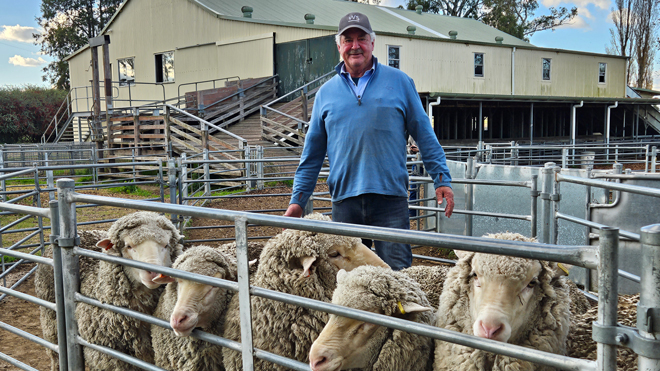
Andrew Calvert, Wool Solutions, with classed as the top 1% New England 2018 drop ewes.
Launching Flystrike Research Breeding Values
Professor Daniel Brown from the Animal Genetics Breeding Unit (AGBU) introduced the newly released Breech strike research breeding values (RBVs) that are the result of combining many years of research data with more recently collected on-farm data including records from the New England MLP site. The development work has been funded by AWI and carried out by AGBU’s Dr Elena Dehnavi who combined the flystrike data across available data sources with genotypes to generate the RBVs. The RBVs indicate a probability of being flystruck and range from -1 to 1. Further work will go into the RBVs before they are released as Australian Sheep Breeding Values (ASBVs) by 2027.
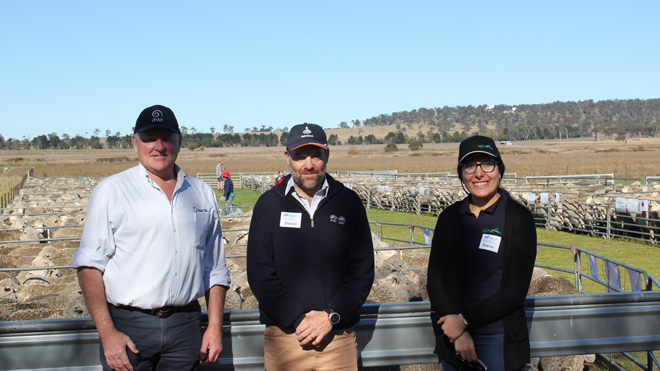
Left to right: AWI’s Geoff Lindon, and AGBU’s Professor Daniel Brown and Dr Elena Dehnavi.
Last of the MLP project sire introductions
The ever-popular sire introductions and results explanation was delivered at the field day by Ben Swain, Executive Officer for the Australian Merino Sire Evaluation Association. Including the sire's background, the reasons for their selection, and an overview of their daughters' performance, sire introductions have been delivered at all five MLP sites. Feedback from each field day indicated that these introductions were an enormously valuable component of the MLP field days.
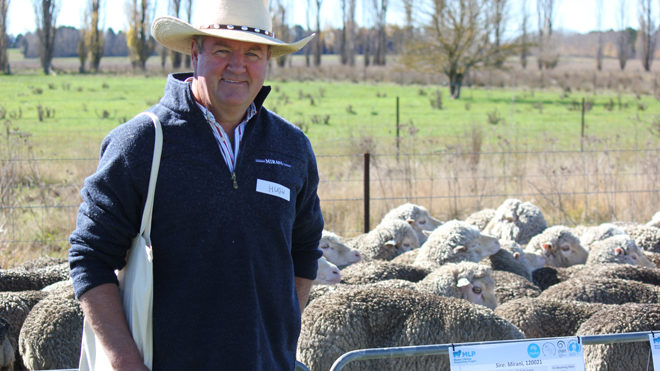
Sire entrant Hugh Nivison in front of the progeny of Mirani 120021.
Engaging presentations
In addition to introducing the sires, MLP project field days have featured industry presentations. At the New England field day, AWI’s Geoff Lindon discussed the upcoming steps for the MLP project’s analysis. CSIRO researcher Amy Bell presented their collaborative work with AWI, which aims to develop a process for selecting Merinos with increased resilience by assessing immune competence and indicator traits. Professor Daniel Brown detailed the AWI-funded efforts to develop ASBVs for flystrike, and Dr Jen Smith, on behalf of Erin Smith, highlighted the crucial role udder structure plays in lamb survival and weaning weights and outlined three new udder and teat traits that have been developed using data collected on the New England MLP F1 ewes.
Next steps
Following the field day, the New England ewes were shorn for the last time ahead of off-shears visual trait scoring which signalled the completion of the MLP project data collection. The ewes will go on to be assessed for methane production and feed intake in a project funded by MLA, UNE and NSW DPIRD.
Thanking the New England site
AWI thanks the New England site that has been hosted by CSIRO in partnership with the New England Merino Sire Evaluation Association. The CSIRO team was led by Dr Jen Smith and supported by a highly capable technical team that included Amy Bell, Graham Acton, Duncan Elks, Grant Uphill and Heather Brewer. AWI also recognises the Chiswick farm staff for their support of the project.
The New England site committee was initially chaired by Duncan Lance during which time several successful field days were held, including an online version during COVID. Midway through the trial, local stud breeder Todd Whillock took over the reins and led the site through the last two well attended field days. Many thanks to the site committee members who helped in the early stages of data collection, and with the success of the field days.
Guiding the site through drought, flood, and COVID was no mean feat. AWI extends its thanks to Jen, the CSIRO team, the site committee for their dedication and for maintaining such a high standard of data quality.
MLP quick facts
The AWI-funded MLP project is a $13 million ($8 million from AWI plus $5 million from project partners), 10-year venture between AWI, the Australian Merino Sire Evaluation Association (AMSEA), nominating stud Merino breeders and site partners.
- Balmoral, Vic
Partner: Tuloona Pastoral
Committee: Balmoral Breeders Association
- Pingelly, WA
Partner: Murdoch University / UWA
Committee: Federation of Performance Sheep Breeders (WA Branch)
- MerinoLink, Temora NSW
Partner: Moses & Son
Committee: MerinoLink Limited
- Macquarie, Trangie NSW
Partner: NSW DPI
Committee: Macquarie Sire Evaluation Association
- New England, NSW
Partner: CSIRO
Committee: New England Merino Sire Evaluation Association
The MLP project has tracked the lifetime performance of 5,700 ewes as they proceeded through four to five joinings and annual shearings.
assessments of a range of key traits and index evaluations along with a DNA genotype at the start and end the of their lives.
A unique and extensive dataset has been created that is being used to enhance existing Merino breeding and selection strategies, for both ram sellers and buyers, to deliver greater lifetime productivity and woolgrower returns now and into the future.
To stay up to date with the latest MLP findings, visit www.wool.com/MLP. Subscribe to MLP updates via www.merinosuperiorsires.com.au/contact-us






